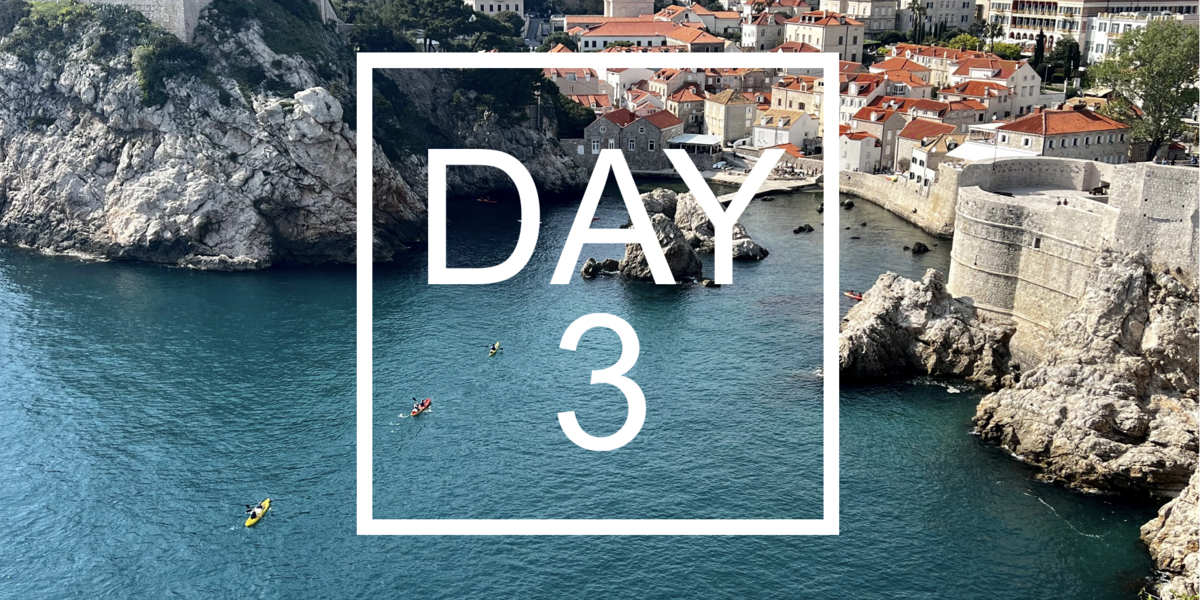HD Therapeutics Conference 2013 Updates: Day 3
Final day of our coverage of the Huntington's Disease Therapeutics Conference 2013
 By Dr Jeff Carroll April 11, 2013 Edited by Professor Ed Wild
By Dr Jeff Carroll April 11, 2013 Edited by Professor Ed Wild
Our daily report from the annual Huntington’s Disease Therapeutics Conference in Venice, Italy on the third and final day of the conference.
9:07 - Day 3 of the HD therapeutics conference starts with a session on the most exciting programs at CHDI, getting close to the clinic.
9:10 - Marg Sutherland of the National Institute of Health is describing the programs there directed at funding and supporting HD research. The National Institute of Health is supporting HD research to the tune of 54 million dollars every year!

9:27 - Margaret Zaleska from Pfizer is describing the pharma giant’s work to develop an exciting new drug for HD. Pfizer’s new drug (“MP-10”) targets something called “phosphodiesterase-10A”. In HD mice, MP-10 has a number of beneficial effects, supporting the idea that it might be useful for patients. Encouragingly, MP-10’s beneficial effects in HD mice last longer than the drug, suggesting it might work on more than symptoms. Pfizer’s completed its imaging trial in HD patients that was intended to help decide whether to go ahead with a drug trial. The answer: YES. Pfizer’s trial will assess safety and tolerability in HD patients and will last 28 days with functional MRI imaging. Pfizer expects its drug trial in HD patients to start in 2014.
10:18 - Ladislav Mrzljak gives update on CHDI’s KMO inhibitor research program. Inhibiting KMO should improve the balance of helpful and harmful brain chemicals in HD. CHDI’s drug is called CHDI246. CHDI246 has been chosen as the lead candidate for its KMO-inhibiting properties but doesn’t get into the brain very well - however, it does good things in the blood that then produce benefits for the brain. CHDI246 produces the kind of chemical changes we want to see in the spinal fluid of HD animal models. CHDI246 doesn’t improve the HD mice. A bit of a surprise but may be because of fundamental differences between mice and people. CHDI’s research questions whether JM6, a previously reported KMO inhibitor, works as the publication claims. Despite negative results in mouse trials, favourable chemical changes in primate tests mean CHDI wants to push ahead with CHDI246.
11:07 - Vahri Beaumont of CHDI is describing their work on “HDAC Inhibitors”. Years of work from Gill Bates at King’s College London suggests that blocking a specific HDAC - HDAC4 - helps HD mice. HDAC4 sticks to the mutant HD protein, but not the regular one. That’s a hint that HDAC4 might be up to no good in HD. Getting rid of half of HDAC4 in HD mice make their neurons work much better, and helps them live longer. CHDI is working to develop a drug to block HDAC4 that could be taken as a pill. CHDI have identified several specific drugs that are potent inhibitors of HDAC4 and are testing them in mice. Beaumont tells us that early data shows blocking HDAC4 with a drug in mice doesn’t show big improvements in HD symptoms in mice treated with it. So there’s a lot of work to do to understand HDAC4 in HD.
11:56 - CHDI’s Jonathan Bard gives an update on TrkB activating drugs (pronounced track-bee!). TrkB activators aim to mimic the ‘nourishing’ effects of the brain chemical BDNF. It keeps neurons alive and is reduced in HD. CHDI is also looking into delivering BDNF directly into the brain using a virus called AAV as a delivery truck. CHDI is testing two antibody-based TrkB activating molecules. Early results from the viral-delivered BDNF in mouse brain look good- it increases TrkB activity, as expected. Very early days for CHDI’s TrkB and BDNF programs but looking good so far. These guys really know their stuff.
14:15 - Next up is the biomarker session, figuring out the best ways to measure and predict progression in HD to help tell if drugs work
14:20 - Beth Borowsky of CHDI presents work relating to a substance called 8OHdG, which has previously been reported as a biomarker for HD. 8OHdG is produced when DNA is damaged and a 2006 paper reported that it was increased in the blood of HD patients. Borowsky has led an incredibly careful multi-lab re-evaluation of 8OHdG in hundreds of blood samples. Borowsky reports that there were actually no differences in 8OHdG at any disease stage, or with progression within patients and 8OHdG is not a biomarker of HD state or progression. Rigorous ‘replication’ like this- carefully repeating others’ findings - is an incredibly important part of science but seldom done. Borowsky says that the Track-HD study ran for 4 years and has identified the best imaging, clinical and cognitive (thinking) biomarkers. The latest data from Track-HD tell us that brain volume and other measures can predict how the disease may progress in future (It’s important to note that these measures are not yet useful in individual patients, only when measured in groups). The next step is to use these measures to help run drug trials in HD patients
14:46 - Borowsky: CHDI also supports the CAB study developing optimised thinking tests for clinical trials in HD. ‘Composite’ cognitive scores, combining the results from several different tests, are probably the best. It’s time to test our most promising biomarkers in a clinical trial.
14:52 - Borowsky announces CHDI’s first human clinical trial - of aerobic exercise in Huntington’s disease! The trial will primarily aim to validate the biomarkers we’ve developed over the last few years. But also whether exercise is good.
15:00 - Tiago Mestre gives an update on the Enroll-HD study, which is now active. Enroll-HD combines, updates and replaces the European Registry study and American Cohort study. Enroll-HD is an observational study- participants are studied but no drug is given. Enroll-HD aims to understand the disease, improve clinical care and enable clinical research (eg biomarkers and future drug trials). People who’ve tested HD positive or negative, people who haven’t had a genetic test, and not-at-risk people can all take part in Enroll-HD. The aim is to recruit a third of the HD-at-risk population in each region where the study is running (North & South America, Europe, Australia).
16:07 - Carole Ho of Genentech gives an update on the Alzheimer Prevention Initiative. We must learn from other neurodegenerative diseases. Most cases of Alzheimer’s disease are not caused by a specific mutation (like HD is), but some cases are. Recent Alzheimer’s drug trials have disappointed, perhaps because the drug was given too late in the disease. However, focusing on the small number of patients with genetic forms of Alzheimer’s enables treatments to be given much earlier. Now Genentech is starting trials of its new drug crenezumab in people with genetic Alzheimer’s even before symptoms. Everyone with HD has the same basic genetic mutation, so preventative or very early trials would be possible. Good news for HD!. The Genentech drug wouldn’t work for HD by the way, but we can learn from this way of doing trials. The FDA has recently relaxed its criteria for approving new Alzheimer’s drugs, making it a little bit easier. The Alzheimer’s trial will include the patients in Colombia whose genetic information was used to develop it - the HD community needs to remember and serve the Venezuelan families where HD is very common and whose DNA helped find the HD gene.
17:00 - The final speaker is Kenneth Marek of Institute for Neurodegenerative disorders, CT USA, an expert on ‘molecular imaging’ methods. Brain scans with names like PET and SPECT allow us to see the chemical changes in the brains of live human beings. Molecular imaging is already available to help diagnose Parkinson’s and Alzheimer’s by measuring buildup of harmful proteins. We don’t yet have a way of scanning patients to measure levels of Huntingtin protein, but it would be very useful and its being worked on. However, other types of imaging could be useful for HD research, like one that measures PDE10, the target for Pfizer’s HD drug.
Sunset conclusions
Tonight marks the end of this year’s HD Therapeutics Conference, and we’re saying goodbye to one another and to Venice. Leaving these meetings is always bittersweet - on the one hand, it’s been a very stimulating few days of cutting-edge HD science, and we’ll return to our work re-energized and fully informed. But at the same time, the inevitable challenges along the way remind of the difficulty of our task, and just how important it is to HD families that we’re successful as quickly as possible.
Amongst this year’s most exciting news is the rapid advancement of Pfizer’s PDE10A drug, enabled by their collaboration with CHDI, towards human clinical trials. The HD mouse data presented here is among the most exciting that we’ve seen for any proposed drug. As well as looking like a very exciting drug candidate, the trials that Pfizer and CHDI have planned take advantage of everything we’ve learned from trials like TRACK-HD and PREDICT-HD, and will be the most advanced ever run in HD.
Gene silencing, too, received an exciting boost this week in the form of the announced multi-million dollar collaboration between biotech Isis and Pharma giant Roche to bring HD silencing drugs to the clinic. Like many scientists, we think that gene silencing is the most promising approach to developing meaningful therapies for HD families, and it’s gratifying that large companies are willing to make a large financial investment in the therapy.
Developing treatments for HD is such a huge challenge that it’s certain that some attempts will fail along the way. For example, some drugs that looked hopeful at early stages of development, including the ‘HDAC4 inhibitors’ from CHDI, now seem perhaps a bit less exciting than we’d hoped. Also, the failure of 8OH-dG as a ‘biomarker’ for HD means we have one less tool in our box for clinical trials. We’d encourage families to join us in thinking of these “failures” as positive developments - helping us focus on the most promising approaches.
The road to effective therapies for HD is long. While we are not at the end of this road yet, it’s clear that we’ve made major progress along the path. The developments presented at this meeting leave us energized, excited and hopeful for the future of HD therapies.


